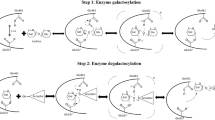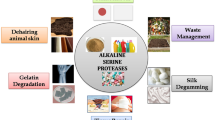Abstract
The halophilic archaeon Haloferax mediterranei is able to grow in a minimal medium containing ammonium acetate as a carbon and nitrogen source. When this medium is enriched with starch, α-amylase activity is excreted to the medium in low concentration. Here we report methods to concentrate and purify the enzyme. The relative molecular mass of the enzyme, determined by gel filtration, is 50±4 kDa, and on SDS-PAGE analysis a single band appeared at 58 kDa. These results indicated that the halophilic α-amylase is a monomeric enzyme. The enzyme showed a salt requirement for both stability and activity, being stable from 2 to 4 M NaCl, with maximal activity at 3 M NaCl. The enzyme displayed maximal activity at pHs from 7 to 8, and its optimal temperature was in a range from 50 °C to 60 °C. The results also implicated several prototropic groups in the catalytic reaction.




Similar content being viewed by others
References
Bhattacharyya DK, Bandyopadhyay U, Banerjee RK (1992) Chemical and kinetic evidence for an essential histidine in horseradish peroxidase for iodine oxidation. J Biol Chem 267:9800–9804
Bonete MJ, Camacho ML, Cadenas E (1986) Purification and some properties of NAD-dependent glutamate dehydrogenase from Halobacterium halobium. Int J Biochem 18:785–789
Bonete MJ, Camacho ML, Cadenas E (1987) A new glutamate dehydrogenase from Halobacterium halobium with different coenzyme specificity. J Biochem 19:1149–1155
Bonete MJ, Pire C, Llorca FI, Camacho ML (1996) Glucose dehydrogenase from the halophilic archaeon Haloferax mediterranei: enzyme purification, characterization and N-terminal sequence. FEBS Lett 383:227–229
Bradford MM (1976) A rapid and sensitive method for the quantification of microgram quantities of proteins utilizing the principle of protein-dye binding. Anal Biochem 72:248–254
Camacho ML, Brown RA, Bonete MJ, Danson MJ, Hough DW (1995) Isocitrate dehydrogenases from Haloferax volcanii and Sulfolobus solfataricus: enzyme purification, characterisation and N-terminal sequence. FEMS Microbiol Lett 134:85–90
Coronado M,Vargas C, Hofemeister J, Ventosa A, Nieto (2000) Production and biochemical characterization of and α-amylase of the moderate halophile Halomonas meridiana. FEMS Microbiol Lett 183:67–71
Danson MJ, Hough DW (1997) The structural basis of halophilicity. Comp Biochem Physiol 117A, 3:307–312
D'Souza SE, Altekar W, D'Souza SF (1997) Adaptive response of Haloferax mediterranei to low concentrations of NaCl (< 20%) in the growth medium. Arch Microbiol 168:68–71
Dym O, Mevarech M, Sussman JL (1995) Structural features that stabilize halophilic malate dehydrogenase from archaebacterium. Science 267:1344–1346
Egas MCV, da Costa MS, Cowan DA, Pires EMV (1998) Extracellular α-amylase from Thermus filiformis Ork A2: purification and biochemical characterization. Extremophiles 2:23–32
Ferrer J, Pérez-Pomares F, Bonete MJ (1996) NADP-glutamate dehydrogenase from the halophilic archaeon Haloferax mediterranei: enzyme purification, N-terminal sequence and stability. FEMS Microbiol Lett 141:59–63
Good WA, Hartman PA (1970) Properties of the amylase from Halobacterium halobium. J Bacteriol 104:1, 601–603
Haseltine C, Rolfsmeier M, Blum P (1996) The glucose effect and regulation of the α-amylase synthesis in the hyperthermophilic archaeon Sulfolobus solfataricus. J Bacteriol 178, 4:945–950
Igarashi K, Hatada Y, Hagihara H, Saeki K, Takaiwa M, Uemura T, Ara K, Ozaki K, Kawai S, Kobayashi T, Ito S (1998) Enzymatic properties of a novel liquefying α-amylase from an alkaliphilic Bacillus isolate and entire nucleotide and amino acid sequences. Appl Environ Microbiol 64:3282–3289
Jones RA, Jermiin LS, Easteal S, Patel BKC, Beacham IR (1999) Amylase and 16S rRNA genes from a hyperthermophilic archaebacterium. J Appl Microbiol 86:93–107
Kadziola A, Søgaard M, Svensson B (1998) Molecular structure of a barley α-amylase-inhibitor complex: implications for starch binding and catalysis. J Mol Biol 278:205–217
Karsten WE, Viola RE (1991) Chemical and kinetic mechanism of aspartate-β-semialdehyde dehydrogenase from Escherichia coli. Biochim Biophys Acta 1077:209–219
Kobayashi T, Kanai H, Hayashi T, Akiba T, Akaboshi R, Horikoshi K (1992) Haloalkaliphilic maltotriose-forming α-amylase from the archaebacterium Natronococcus sp. strain Ah-36. J Bacteriol 174:3439–3444
Lee SK, Kim YB, Ji GE (1997) Note: Purification of amylase secreted from Bifidobacterium adolescentis. J Appl Microbiol 83:267–272
Lévêque E, Haye B, Belarbi A (2000) Cloning and expression of and α-amylase from the hyperthermophilic archaebacterium Thermococcus hydrothermalis and biochemical characterisation of the recombinant enzyme. FEMS Microbiol Lett 186:67–71
Machius M, Wiegand G, Huber R (1995) Crystal structure of calcium depleted Bacillus lincheniformis α-amylase at 2.2 A resolution. J Mol Biol 246:545–559
Machius M, Declerck N, Huber R, Wiegand G (1998) Activation of Bacillus lincheniformis α-amylase through a disorder transition of the substrate-binding site mediated by a calcium-sodium-calcium metal triad. Structure 6:281–292
Madern D, Ebel C, Zaccai G (2000) Halophilic adaptation of enzymes. Extremophiles 4:91–98
Marhuenda-Egea FC, Bonete MJ (2002) Extreme halophilic enzymes in organic solvents. Curr Opin Biotechnol 13:385–389
Marhuenda-Egea FC, Piera-Velázquez S, Cadenas C, Cadenas E (2001) Stability of an extreme halophilic alkaline phosphatase from Halobacterium salinarium in non-conventional medium. J Biotechnol 87:255–261
Martinez-Espinosa RM, Marhuenda-Egea FC, Bonete MJ (2001) Assimilatory nitrate reductase from the haloarchaeon Haloferax mediterranei: purification and characterization. FEMS Microbiol Lett 204:381–385
Mijts BN, Patel BKC (2002) Cloning, sequencing and expression of and α-amylase gene, amyA, from the thermophilic halophile Halothermothrix orenii and purification and biochemical characterization of the recombinant enzyme. Microbiology 148:2343–2349
Nakamura N, Sashihara N, Nagayama H Horikoshi (1989) Characterization of pullulanase and α-amylase activities of a Thermus sp. AMD33. Starch 41:112–117
Nielsen JE, Borchert TV (2000) Protein engineering of bacterial α-amylases. Biochim Biophys Acta 1543:253–274
Pérez-Pomares F, Ferrer J, Camacho M, Pire C, Llorca F, Bonete MJ (1999) Amino acid residues implied in the catalytic mechanism of NAD-dependent glutamate dehydrogenase from Halobacterium salinarum Biochim Biophys Acta 1426:513–525
Rodriguez-Valera F. Ruiz-Berraquero F Ramos-Cormenzana A (1980) Isolation of extremely halophilic bacteria able to grow on defined organic media with single carbon sources. J Gen Microbiol 119:535–538
Rodriguez-Valera F, Juez G, Kushner DJ (1983) Halobacterium mediterranei spec. nov., a new carbohydrate-utilizing extreme halophile. Syst Appl Microbiol 4:369–387
Segel IH (1993) Enzyme kinetics. Behavior and analysis of rapid equilibrium and steady-state enzyme system. Wiley, New York
Serrano JA, Camacho M, Bonete MJ (1998) Operation of glyoxylate cycle in halophilic archaea: presence of malate synthase and isocitrate lyase in Haloferax volcanii. FEBS Lett 434:13–16
Strobl S, Maskos K, Betz M, Wiegand G, Huber R, Gomis-Rüth X, Glockshuber R (1998) Crystal structure of yellow meal worm α-amylase at 1.64 A resolution. J Mol Biol 278:617–628
Sunna A, Moracci M, Rossi M, Antranikian G (1997) Glycosyl hydrolases from hyperthermophiles (1997). Extremophiles 1:2–13
Vihinen M, Mäntsälä P (1989) Microbial amylolytic enzymes. Crit Rev Biochem Mol Biol 24:329–418
Acknowledgements
We thank Dr. J.M. Sansano Gil (Department of Organic Chemistry, University of Alicante) for collaboration in the polarimetry studies. RMN experiments and HPLC were carried out at the Servicios Técnicos de Investigación de la Universidad de Alicante (Spain). This work was supported by funds from CICYT-PB98-0969 and GV01-120.
Author information
Authors and Affiliations
Corresponding author
Additional information
Communicated by W.D. Grant
Rights and permissions
About this article
Cite this article
Pérez-Pomares, F., Bautista, V., Ferrer, J. et al. α-Amylase activity from the halophilic archaeon Haloferax mediterranei . Extremophiles 7, 299–306 (2003). https://doi.org/10.1007/s00792-003-0327-6
Received:
Accepted:
Published:
Issue Date:
DOI: https://doi.org/10.1007/s00792-003-0327-6




